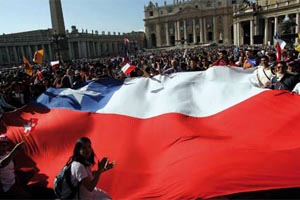He was born on January 22nd of 1901 in Viña del Mar, his parents were Alberto Hurtado Larrain y Ana Cruchaga Tocornal. As his progenitor died when he was four years old, he moved to Santiago along with his mother and brother.
In the capital, he entered the San Ignacio School in 1909, where he stood out for being an excellent student and a good classmate. At that time he became a member of the Mariana Congregation, where he became interested in the most deprived people, by doing social works every Sunday among the neighborhoods in which they lived.
Before finishing his student life, the priestly calling awoke in him, thus requesting his admission into the Compañia de Jesus noviciate, but his spiritual advisers recommended to him to delay this due to the economical problems that his family was going through.
Faced with this situation, Alberto decided to enter the Universidad Catolica to study law (1918) and work in the Diario Ilustrado during the afternoon.
However, in 1920 he had to do his extraordinary military service in the Yungay Regime (which had moved to Santiago temporarily), which interrupted his studies for some time.
Finally, he graduated as a lawyer in August of 1923. Days later, he entered the Compañia de Jesus noviciate in Chillan. In 1925, he moved to Cordova (Argentina), where he finished his noviciate period and was consecrated with his religious vows.
In 1927, he was sent to Spain to achieve his Philosophy and Theology studies, but four years later, due to the expulsion of the Jesuits, he abandoned that country and went to Lovaina (Belgium), where he was ordained as a priest on august 24th of 1933.
Return to Chile
In January of 1936, he returned to the country, initiating his pastoral work as a Religion teacher in the San Ignacio School and as a Pedagogy teacher in the Universidad Catolica (Catholic University) and in the Pontiff Seminar. In addition, he was the director of the Mariana Congregation of the Youth.
In 1941, he published his most known and polemic book at that time, Is Chile a Catholic Country?
That same year, he was entrusted with the position of adviser of the youth branch of the Acción Catolica (Catholic Action) of the Archdiocese of Santiago, and in the following year, of all the country.
In October of 1944 – after resigning from this organization – during a retreat with a group of women he felt the necessity of making a calling to the consciousness in regards of the poverty that the people had, especially children. This discourse profoundly impressed his listeners, thus generating important donations of money, in addition to a land. This is how father Hurtado’s most important and well known project began.
In September of 1945, the fist shelter for children was opened, and then one for women and another one for men. As time passed, this work started to multiply and acquired new features.
For example, some shelters became rehabilitation centers, others became technical instruction centers, etc. In addition, father Hurtado went about every night in his green truck picking up children from the streets.
On June 13th of 1947, the priest along with a group of college students founded the Asociación Sindical Chilena (Asich) (Chilean Union Association), with the purpose of promoting the inspired syndicalism in the social doctrine of the Church.
Between 1947 and 1950, he wrote three important books: Syndicalism, Social Humanism and the Social Christian Order in the Documents of the Catholic Hierarchy.
The long process to become a saint
On august 29th of 1974, the archbishop of Santiago, cardinal Raul Silva Henriquez, requested to the Congregation for the Causes of Saints the authorization to induct padre Hurtado’s cause. Two years later, the Congregation accepted it with the decree Nihil obstat («nothing prevents»).
In January of 1977, the cardinal dictated the opening decree and constituted the Hearing to begin the God’s Servant cause. In 1982, father Paolo Molinari, general postulator, gave to the Congregation the writings of father Hurtado, authenticated by a notary. These were taken to Rome by father Renato Poblete.
In December of 1987, the Positio was presented to the Congregation (ordered presentation) in order to access the category of Venerable.
In march of 1991, the Positio discussion was started by the consulting committee of theologians of the Congregation, being unanimously approved.
In June of that year the vice postulator of the cause gave to the archbishop of Santiago, monsignor Carlos Oviedo, the records of a presumed miracle attributed to father Hurtado.
The following year, the Congregation opened the process for the possible miracle, being approved by the Consulta Medica (Medical Consultants) (five experts designated by the Congregation) in February of 1993.
In December of that year, the Pope John Paul II signed the Decree of the Beatification. On October 16th of 1994, the liturgical ceremony of Beatification of father Hurtado took place.
In April of 2001, in Valparaiso, the investigation for the second miracle attributed to this priest began, sending the files to Rome in October. A year later, it was declared that the healing of the beneficiary was unexplainable for the medical science. In April of 2004, the Congregation approved the second miracle and a few days later, Pope John Paul II authorized the Decree of the Canonization.
Finally, on October 23rd of 2005, father Alberto Hurtado was declared a Saint by Pope Benedict XVI.





 Muere Evita
Muere Evita